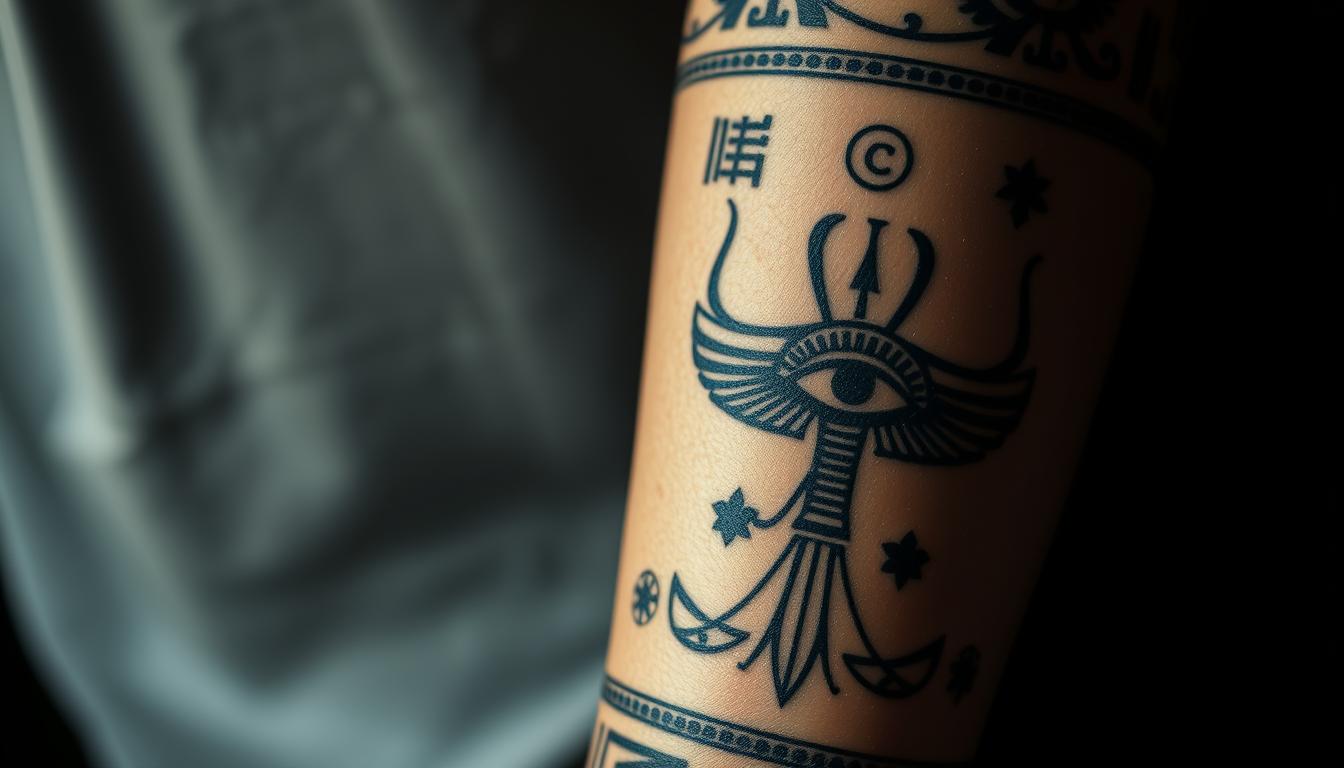
Egyptian tattoos have captivated people for centuries with their deep spiritual significance and stunning visual appeal. These ancient symbols offer a wealth of meaning and beauty, allowing individuals to connect with one of the world’s oldest and most influential civilizations.
From the mesmerizing Eye of Horus to the transformative Scarab Beetle, Egyptian mythology tattoos are truly enchanting. These hieroglyphic designs carry profound symbolism and cultural significance, originally used as talismans to safeguard the wearer from negative energies and physical harm.
Key Takeaways
- Egyptian tattoos represent one of the oldest forms of body art, with a rich history and cultural significance.
- These symbols were used as talismans for protection against negative energies and physical harm.
- Modern enthusiasts are drawn to Egyptian tattoo designs for their aesthetic beauty and protective symbolism.
- Each symbol carries its own unique meaning and energy, such as the Eye of Horus and Scarab Beetle.
- Understanding the deeper meanings behind these symbols can help you choose a protective Egyptian tattoo that resonates with your personal journey.
The Ancient Power of Egyptian Protective Symbols
The ancient Egyptians harnessed the power of protective symbols, embedding them in their culture and daily life. These symbols were not just decorative; they carried deep spiritual significance and were believed to offer protection in various aspects of life.
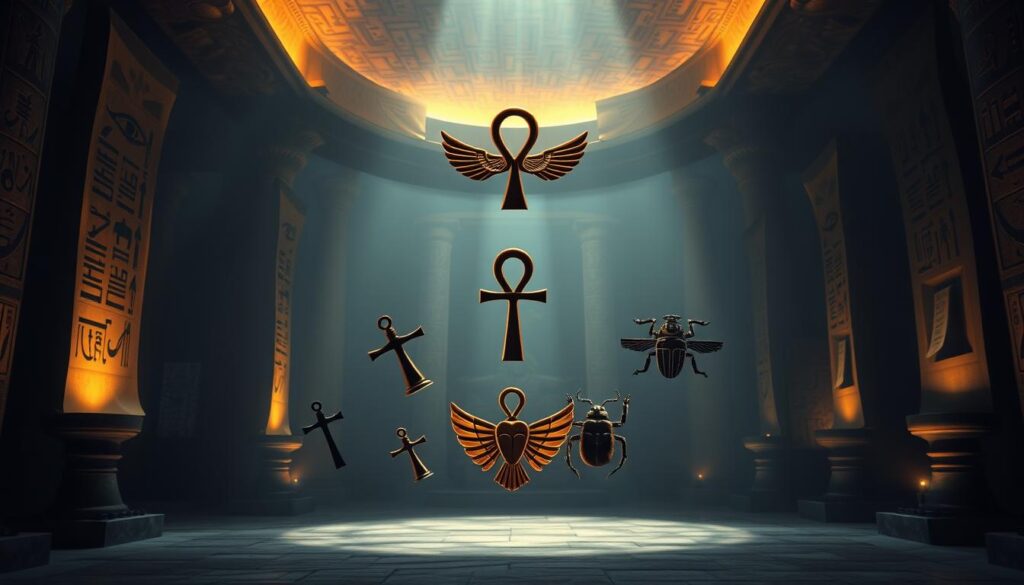
Historical Significance of Tattoos in Ancient Egypt
Egyptian tattooing dates back thousands of years, with evidence found on mummified bodies from the Middle Kingdom (c. 2000 BCE). Tattoos, often seen on women, featured dots, lines, and geometric patterns, possibly for religious or protective purposes. The practice was common among priestesses and dancers, linking them to fertility and divine worship.
The Connection Between Egyptian Symbols and Protection
The connection between Egyptian symbols and protection was rooted in their religious belief system. Symbols served as conduits between the mortal and divine realms, offering various forms of protection. Many protective symbols were associated with specific deities who offered different forms of protection, from physical safety to spiritual guidance. By wearing these symbols permanently on the skin through tattoos, ancient Egyptians believed they created a lifelong bond with the protective energies they represented.
As stated by historians, “
the use of protective symbols in ancient Egyptian culture was a testament to their deep understanding of spiritual protection and their desire to connect with the divine
.” This understanding continues to inspire modern tattoo enthusiasts who seek the same protective qualities that ancient Egyptians valued thousands of years ago.
The Eye of Horus: Ultimate Symbol of Protection
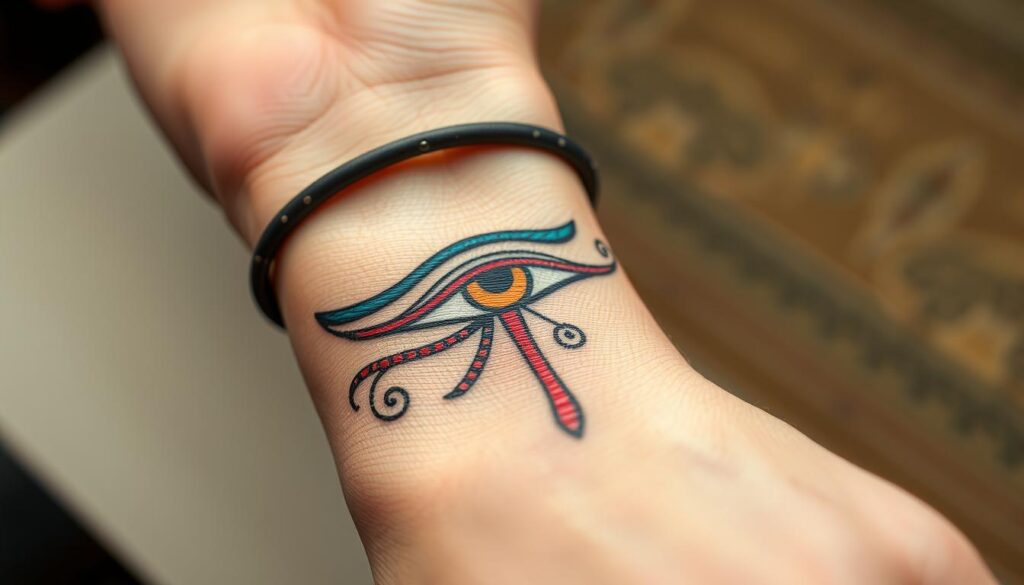
With roots in ancient mythology, the Eye of Horus stands as a potent symbol of protection and divine watchfulness. The Eye of Horus is associated with the falcon-headed god Horus, who had his eye injured and later restored by the god Thoth, symbolizing healing and restoration.
Mythology and Origin
The mythology surrounding the Eye of Horus is deeply rooted in ancient Egyptian beliefs. According to myth, Horus’s eye was injured during a battle with his uncle Set, and its subsequent healing by Thoth made it a powerful symbol of protection, healing, and restoration. The six parts of the Eye of Horus correspond to the six senses in Egyptian belief, representing different aspects of protection and perception.
Modern Interpretations and Tattoo Designs
In modern times, the Eye of Horus tattoo has become a popular choice for those seeking protection and spiritual safeguarding. The symbol is often incorporated into various tattoo designs, ranging from traditional blackwork to stylized versions with contemporary elements. Placement of the tattoo is significant, with common locations including the back of the neck, wrist, and over the heart, each chosen for its symbolic value in protection.
Powerful Protection Egyptian Tattoos and Their Meanings
The ancient Egyptians revered certain symbols, which have now become powerful protection Egyptian tattoos, embodying eternal life and divine protection. These tattoos not only serve as a form of body art but also as a connection to the rich cultural heritage of Egypt.
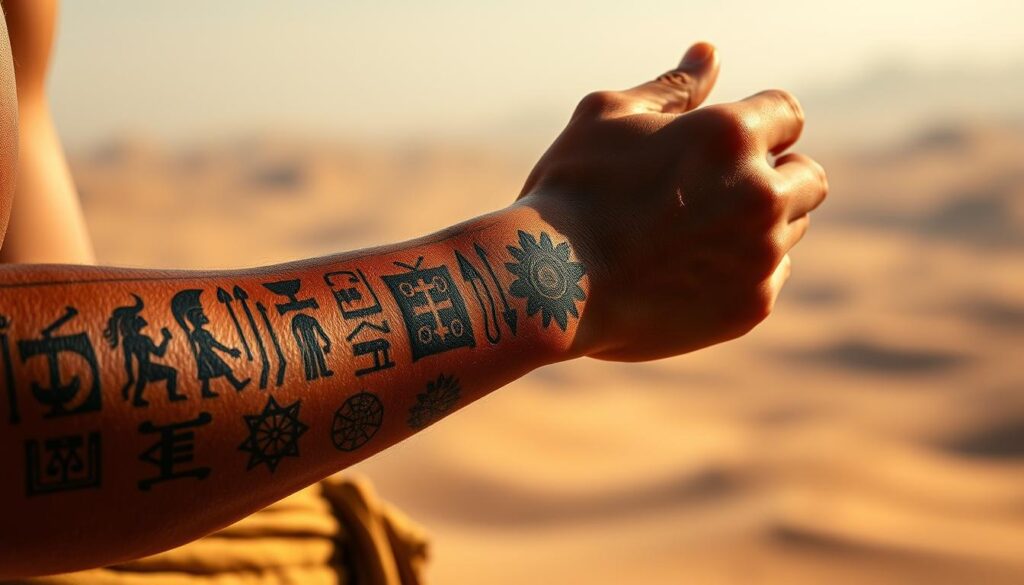
The Ankh: Symbol of Eternal Life and Divine Protection
The Ankh, often referred to as the “key of life,” is a potent symbol representing eternal existence and the union of opposites. As a tattoo, it signifies the connection between mortal life and immortality, offering protection that transcends physical existence.
- The Ankh’s distinctive loop-topped cross design makes it visually striking and instantly recognizable as a symbol of Egyptian protection.
- As a tattoo, the Ankh serves as a powerful reminder of life’s eternal cycle, symbolizing eternal life and divine safeguarding.
Scarab Beetle: Transformation and Protective Renewal
The sacred Scarab Beetle embodies transformation, rebirth, and the eternal cycle of life. As a tattoo, it symbolizes renewal and protection, tapping into the transformative power of Egyptian beliefs.
- The Scarab Beetle tattoo is inspired by the ancient Egyptian belief in the beetle’s connection to the sun god Ra, making it a symbol of rebirth and cyclical protection.
- Scarab Beetle tattoos often incorporate wings or solar imagery to enhance their protective qualities and connection to divine transformation.
Protective Egyptian Deities in Tattoo Art
Egyptian deity tattoos offer specific forms of protection based on each god’s domain. For instance, Anubis, the Guardian of the Afterlife, provides protection during transitions and guidance in the unknown.
Anubis: Guardian of the Afterlife
Anubis tattoos are particularly meaningful for those seeking protection during major life transitions or honoring deceased loved ones.
Bastet: Feline Goddess of Protection
Bastet, the feline goddess, offers a unique blend of fierce protection and nurturing energy, making her an ideal protective symbol for those who value both strength and compassion.
Sacred Hieroglyphics and Lesser-Known Protective Symbols
Beyond well-known symbols, hieroglyphics provide a unique protective element in Egyptian tattoos. The ancient Egyptians believed that the written word held magical power, making hieroglyphic tattoos particularly potent as protective symbols.
Protective Hieroglyphic Combinations
Protective hieroglyphic combinations can be tailored to address specific concerns, with certain symbols working together to create a comprehensive shield of protection. These combinations often incorporate personalized elements, such as birth dates or significant numbers translated into Egyptian numerals. The placement of hieroglyphic tattoos is traditionally aligned with the body’s energy centers to maximize their protective qualities.
The Djed Pillar and Was Scepter: Symbols of Stability and Power
The Djed Pillar, representing the backbone of Osiris, symbolizes stability, endurance, and strength. The Was Scepter, carried by Egyptian deities, represents power and dominion, offering protection through authority and control. These symbols can be combined with other protective hieroglyphics to create a powerful tattoo.
| Symbol | Meaning |
|---|---|
| Djed Pillar | Stability, Endurance, Strength |
| Was Scepter | Power, Dominion, Authority |
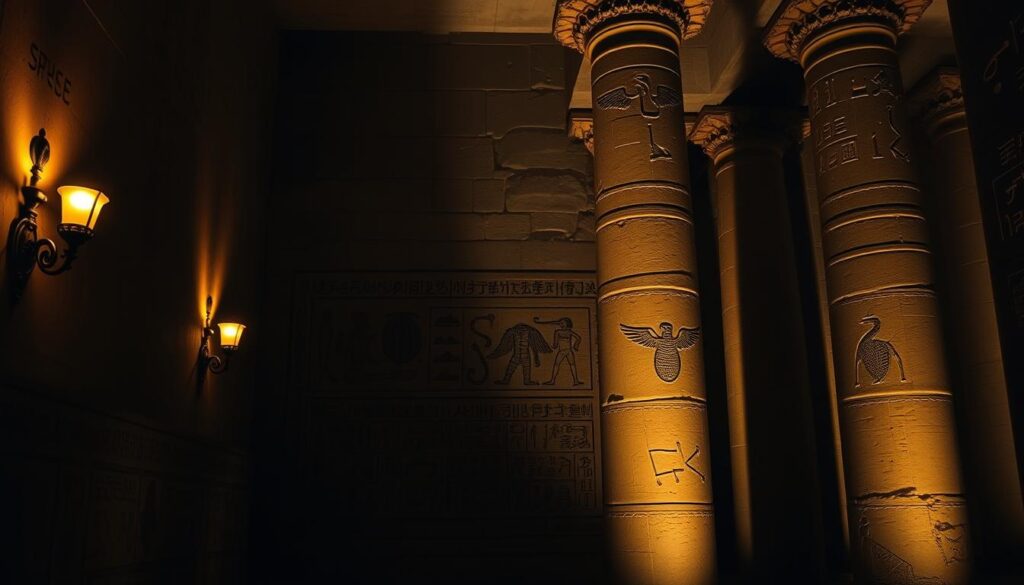
Incorporating Protection Egyptian Tattoos in Modern Body Art
The fusion of ancient Egyptian protective symbols with modern tattoo techniques has given rise to a new wave of meaningful body art. This blend of old and new allows individuals to wear powerful symbols of protection on their skin, combining historical significance with personal style.
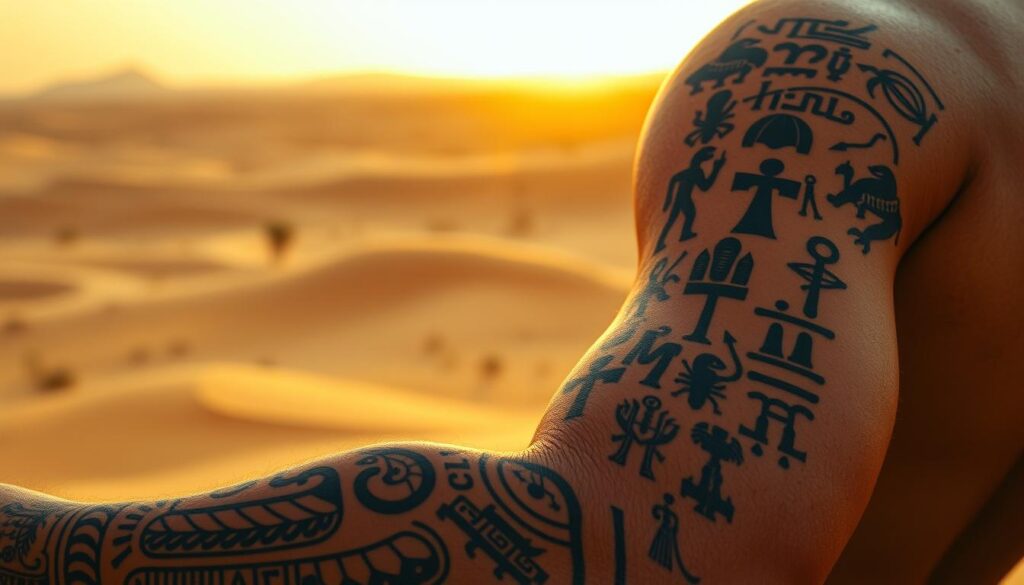
Placement Considerations
When it comes to protection Egyptian tattoos, placement is crucial for maximizing their perceived protective energy. Traditional locations such as the inner wrist, back of the neck, and over the heart are popular choices, as they are believed to enhance the symbol’s power.
Combining Symbols
Combining multiple protective symbols creates a comprehensive shield of protection, addressing various aspects of safety and well-being. Popular combinations include the Eye of Horus with the Ankh, symbolizing vigilant protection and eternal life, or the Scarab with the Djed Pillar, merging transformation with stability.
Modern tattoo techniques have breathed new life into ancient Egyptian symbols, making them more accessible to contemporary enthusiasts. Styles such as fine line work, watercolor, and geometric styling offer a fresh perspective on traditional protective art.
- Modern body art has embraced protection Egyptian tattoos, adapting ancient symbols to contemporary styles.
- Tattoo artists guide clients on optimal placement based on the specific protection sought.
- Custom designs blend personal elements with traditional Egyptian symbols.
Conclusion: Embracing Ancient Protection Through Timeless Art
Protection Egyptian tattoos offer a unique blend of historical significance and personal expression. These ancient symbols resonate deeply, connecting wearers to history and expressing individuality. By choosing an Egyptian protection tattoo, you’re not just adorning your body with beautiful art; you’re connecting with a tradition of spiritual safeguarding that spans thousands of years.
For more insights on tattoo symbolism, you can explore what the Bible says about tattoos. The Eye of Horus and Scarab Beetle are among the symbols that embody protection, transformation, and renewal. Embracing these timeless symbols allows you to carry a piece of history with you, expressing your individuality while honoring ancient wisdom.
